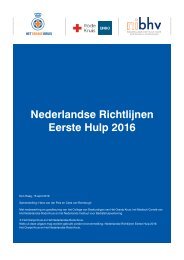Thesis-Anne-Vos-Masters-SBR-and-EU-Law-3
Thesis-Anne-Vos-Masters-SBR-and-EU-Law-3
Thesis-Anne-Vos-Masters-SBR-and-EU-Law-3
Create successful ePaper yourself
Turn your PDF publications into a flip-book with our unique Google optimized e-Paper software.
It should be kept in mind, according to the Commissions’ Communication <strong>and</strong> the case law of the<br />
Court, that reliance on the precautionary principle does not release the obligation to also take<br />
account of other general principles when making measures. Here, the Commission refers to the<br />
general principles of proportionality, non-discrimination, consistency, examination of the benefits<br />
<strong>and</strong> costs of action or lack of action <strong>and</strong> last, the examination of scientific developments. The Court<br />
also refers to these principles often. She assesses whether the action associated with the<br />
protective measures is proportionate to the assumed risk. 338<br />
With regard to the Court, it is also necessary to examine how she applies the precautionary<br />
principle in her case law; does she apply the principle as an independent test norm or as an implicit<br />
norm, depending on other regulation (for which the principle is the underlying objective)? 339 The<br />
first cases in which the CJ<strong>EU</strong> addresses the precautionary principle, she only assesses marginally<br />
(due to the discretionary power of the Commission). Here, she applies the precautionary principle<br />
as part of the proportionality test. 340 The Court does thus not apply the principle as an independent<br />
test norm. However, in later case law, the CJ<strong>EU</strong> seems to have a change of heart. In the case of<br />
Antibiotica, the General Court discusses the precautionary principle <strong>and</strong> her boundaries broadly. 341<br />
Also in the case of Artegodan, the Court applies the principle independently. 342 However, these<br />
latter two cases seem exceptions to the rule; in general, the Court seems to use the precautionary<br />
principle not as an independent test norm, but as an implicit test, depending on other regulation.<br />
See e.g. case Monsanto in which the Court again applies the principle as an instrument of<br />
interpretation. 343 However, in a recent case of France v Commission, the CJ<strong>EU</strong> explicitly speaks of<br />
a breach of the principle itself. 344 This again suggests a more independent application of the<br />
principle. All in all, the case law of the court on this subject is not crystallised (yet).<br />
The CJ<strong>EU</strong> has given in the Kokkelvisserij-case her view on the principle’s substance, which has<br />
recently been confirmed by the Court in the case of Sweetman. 345 The case concerned the<br />
interpretation of Article 6(3) of the Habitat Directive. Here, it was questioned whether the<br />
precautionary principle had to be taken into account when carrying out the ‘appropriate<br />
assessment’ (which assessment is explained in Chapter 3). According to Article 6(3) an<br />
appropriate assessment has to be carried out if there is a probability or a risk that the plan of<br />
project in question will have significant effect on the site concerned. The Court decides that, in light<br />
of the precautionary principle, such a risk exists “if it cannot be excluded, on the basis of objective<br />
information, that [the plan or project] will have a significant effect on that site, either individually or<br />
in combination with other plans or projects.” 346 Hence, in case of doubt as to the absence of<br />
significant effects such an assessment must be carried out. This assessment should be based on<br />
the best scientific knowledge in the field. Only where no reasonable scientific doubt remains as to<br />
the absence of adverse effects on the integrity of the site, authorization may be granted by the<br />
competent authority. This authorisation criterion integrates the precautionary principle. 347<br />
338<br />
Case C77/09, Gowan Comércio Internacional e Serviços Lda v Ministero della Salute [2010] ECR I-13533, paragraph<br />
76; Case C333/08, Commission v France [2010] ECR I0000, paragraph 93, <strong>and</strong> the case-law cited therein.<br />
339<br />
Fennis (2012), p. 35 <strong>and</strong> further.<br />
340<br />
Case C-180/96, United Kingdom v Commission [1998] ECR I-02265, paragraphs 62-63; <strong>and</strong> Case T-199/96, Bergaderm<br />
SA <strong>and</strong> Goupil v Commission [1998] ECR II-02805, paragraphs 65-67.<br />
341<br />
Case T-13/99, Pfizer Animal Health SA v Council [2002] ECR II-03305, paragraphs 136-173.<br />
342<br />
Case T-429/05, Artegodan GmbH v Commission [2010] ECR II-00491, paragraph 125.<br />
343<br />
Fennis (2012), p. 37; Cases C-58/10-C-68/10, Monsanto SAS <strong>and</strong> others v Ministre de l’Agriculture et de la Pêche<br />
[2011] ECR I-07763, paragraph 71.<br />
344<br />
Case C-601/11 P, France v Commission [2013] not yet published, paragraphs 56-57.<br />
345<br />
Case C-127/02 Waddenvereniging <strong>and</strong> Vogelbeschermingsvereniging [2004] ECR I7405, paragraph 44; <strong>and</strong> Case C-<br />
258/11 Sweetman <strong>and</strong> Others [2013] not yet published, paragraphs 28-41.<br />
346<br />
Ibid, paragraph 45.<br />
347<br />
Ibid, paragraphs 56-59. See also Case C127/02 Waddenvereniging <strong>and</strong> Vogelbeschermingsvereniging [2004] ECR<br />
I7405, paragraphs 56 to 59.<br />
70



